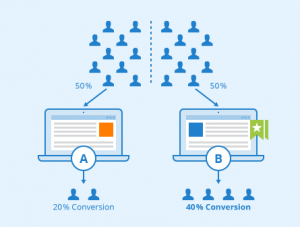A/B testing (also known as split testing) is one of the most efficient ways of optimizing your digital marketing strategy.
If you’re seeing low conversion rates from campaigns, A/B testing is a great way to pinpoint which features are effective and which are turning customers away.

Using A/B testing alongside other methods such as agile testing and automated testing means you’re getting feedback from real customers. While your automated tests might find the most technically efficient ways of running your app or website, they may miss features that are off-putting on a human level.
If at this point you’re asking “what is automated testing?”, don’t worry – automated testing is simply the process of using testing software to check the functionality of your app or website before you release it to the public.
A/B testing comes after, once you have a customer base and want to fine-tune your site to maximize conversion rates.
As your marketing campaign evolves, an integrated system of continuous A/B testing allows you to check in with your customers and ensure your digital marketing strategy is as effective as possible.
What is A/B testing?
A/B testing is a method for testing the effectiveness of marketing assets. It’s best known for its use in designing websites and email campaigns.
An A/B test compares two versions of a variable. In the marketing industry, this means presenting both versions to the business’ customer base under controlled conditions, gathering enough data to form a statistically significant sample, and then analyzing the results to discover which (if either) variable was most effective.

Source: Seobility
You might use A/B testing when designing marketing emails, ads, apps, loyalty programs, brochures, videos, blogs, or influencer content. It’s also useful for testing the efficacy of eCommerce automation features such as chatbots and self-directed customer service.
If you’re designing marketing content, A/B testing allows you to measure the performance of each aspect of your campaign. It’s a flexible method of testing and applies not only to visual mediums but can be used to test which channels of communication customers prefer.
For example, if you’re receiving a high number of calls each day, you might consider running an A/B test trialing multiple line phone systems as opposed to single-line phones. The results of the test would inform you whether making the switch to a multi-line system is worthwhile.
You could also use A/B testing to find out whether customers prefer to contact your company through virtual local phone numbers or traditional landlines.
Similarly, A/B testing can provide you with statistics regarding whether it’s worth investing in a pro video player over a free version, or whether customers would rather chat with a bot or wait for a human customer service rep.
How to integrate A/B testing into your digital marketing strategy
For A/B testing to be effective, you need an already-developed digital marketing strategy and some idea of what you’re aiming for. You should approach it as a useful testing tool to have in your repertoire but not the sole driver of your strategy.

Working out how to perform A/B testing as part of a wider marketing campaign requires an in-depth knowledge of the content you’re aiming to promote. Once you’ve decided on a clear set of goals for your campaign, you can test specific features to see how they perform against this goal.
It’s important to have a clear structure for your A/B testing program. This means that as part of your digital marketing strategy, you should define the overall aims of each campaign. For example, you might want to see an improvement in conversion or download rates or a decrease in cart abandonment and bounce rates.
Using this structured approach to A/B testing means that before you run the tests, you need to have a clear idea of the problem you’re trying to solve. You then need a proposed solution. This might be a new call to action button on your page or a button at the top of the page so mobile users don’t have to scroll.
Once you have your proposed changes, define the sample size and time needed to allow your test to achieve statistical significance. Most experts suggest running your test for at least two weeks, but the number of people participating is more important than the amount of time the test runs for. There are various tools to help you calculate the best sample size for your business.
Regardless of how long you run the test, you must be careful that each variation endures for the same amount of time, is run at the same time of day, and has no external factors such as Christmas or Black Friday that might influence customer behaviors.
Be open to exploring more than one solution until you reach your goal. This means you might need to run multiple A/B tests throughout your marketing campaign to maximize the efficiency of your content.
It’s worth noting that as your business evolves and your customer base expands, the requirements for effective content marketing might change. A continuous A/B testing process will allow you to adapt your advertising to evolving user behavior.
Tips for effective A/B test integration
- Look at your analytics before you design your tests. Find out where your customers are getting ‘stuck.’ Consider which pages have high bounce rates, which ads have low click-through rates, and which email campaigns aren’t getting opened.
- Set specific goals. The more specific these are, the easier it is to measure performance. Choose a quantifiable goal, like the number of new email sign-ups, rather than a subjective one like increased interest in the product.
- Test one element at a time. Make sure you’re changing only one thing in each test, and run a control with your original content as well. This lets you see exactly which aspects of your marketing campaign are doing well.
- Start with the most important page. Your landing page can make or break your conversion rates, so you want it to be as efficient as possible.
- Achieve statistical significance. Exact sample sizes will vary but ensure you run your tests with a big enough sample and for at least two weeks.
How to do A/B testing for video marketing
If you’re using videos as part of your marketing campaign, whether on your website or as part of your ads, A/B testing is both essential and complex. Because videos require a significant investment to create, they must have great conversion rates. However, as they involve a period of engagement from the viewer, there are multiple points where your audience can lose interest.
With that kept in mind, A/B testing for videos is essential to ensure you have the best success rates. Some of the most common video features to test are the title, thumbnail, and call to action.
The title and thumbnail are instrumental in convincing customers to even watch your video, which means that if they’re not working, any content in the video is going unheard.
With the increasing popularity of video ads as marketing tools, if you aren’t optimizing your ads for maximum viewer engagement, you’re likely to be missing out on a significant amount of interest from potential customers. Some video ads do better than others, but which features make those ads successful while their counterparts flop?
One of the most important video features to A/B test is the format. Are you presenting your videos in vertical, landscape, or square format? This 2021 study found that, on Facebook, vertical videos generated more engagement than any other format.

Source: socialinsider
That’s right – if you’re currently advertising on Facebook using landscape videos, it might be time to run an A/B test to see if switching to a vertical format will deliver better results!
A/B testing as part of a dynamic marketing strategy
A/B or split testing is a useful marketing tool to ensure your advertising campaign is as efficient as possible. It allows you to trial potential features of your website, email campaign, brochures, and social media content and provides a quantifiable result regarding which options will lead to better user engagement.
Successful A/B testing results in a list of features that are proven to have high levels of engagement. Using these allows you to tailor your marketing campaigns to your audience for maximum effectiveness.
The more A/B tests you run for each aspect of your digital marketing campaign, the more accurate your results will be. It’s important to run tests for long enough that the sample size reaches statistical significance, though this number will vary according to your field.
As your company and ad campaigns grow, you’ll want to run periodic A/B tests to check your digital marketing strategies are reaching their full potential.









